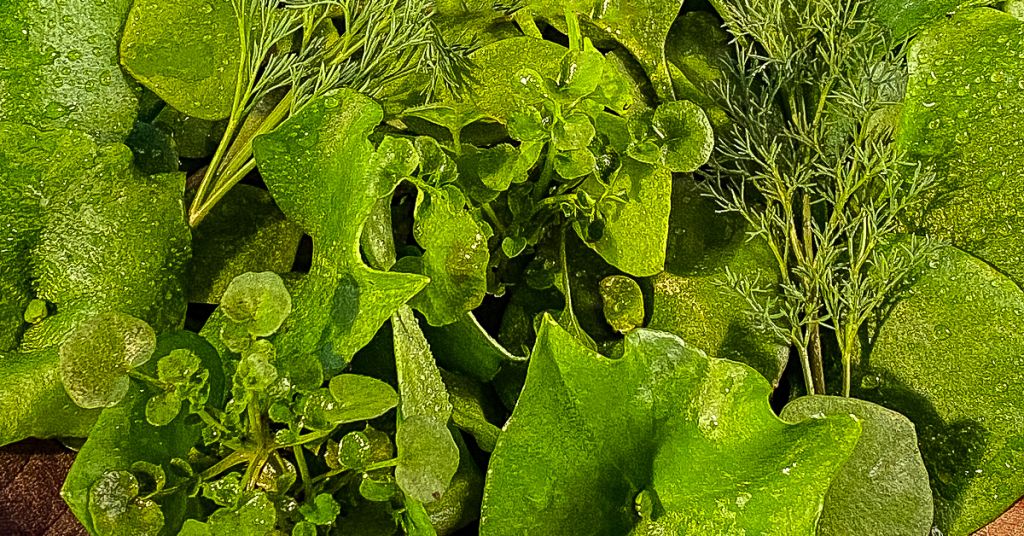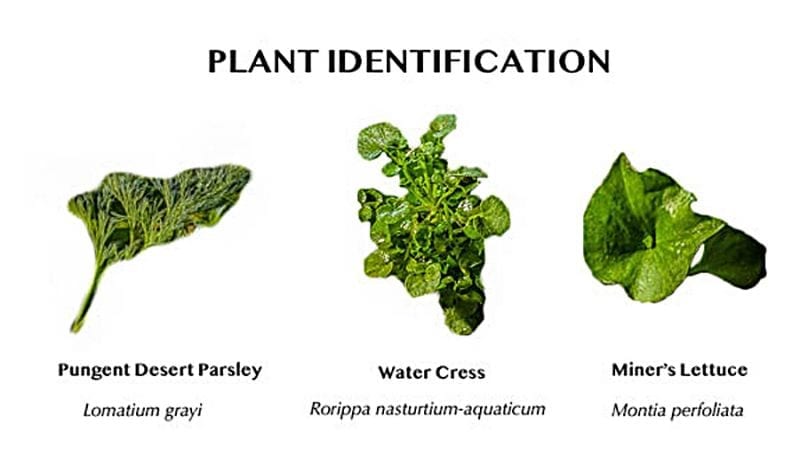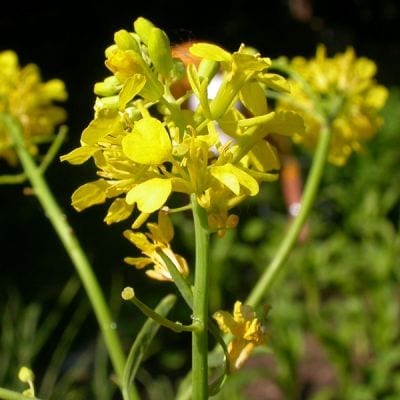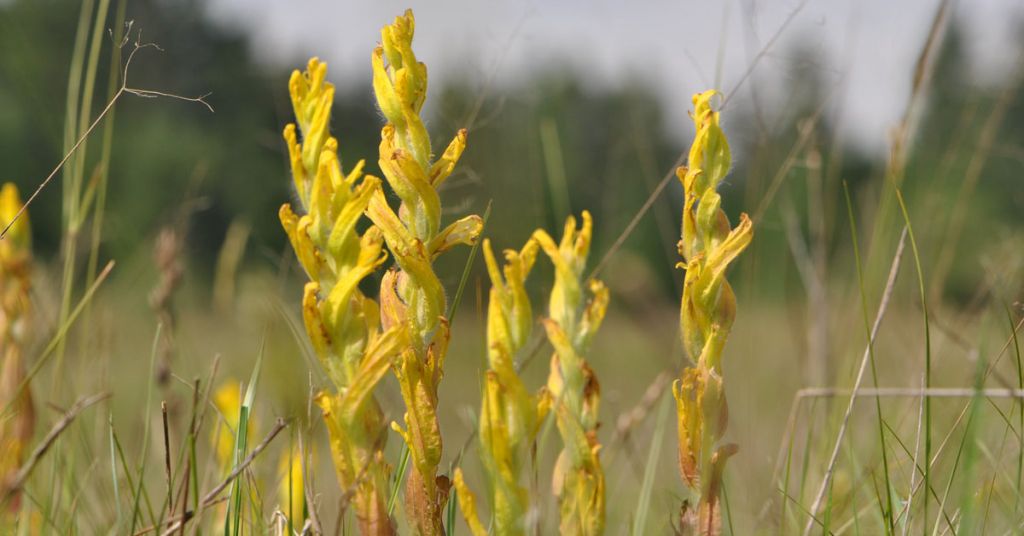The ingredients for a wild, native salad could be growing nearby

Spring greens: Ingredients foraged for this salad include miner’s lettuce, desert parsley and water cress. Photo by Suzi Conklin
By Suzi Conklin. April 1, 2021. Over the past year of the COVID-19 pandemic, we’ve seen how immune systems are a major factor in our ability to survive the virus. The human race didn’t get through millennia on manufactured medications and packaged foods.
We got here by eating and healing with what was found in nature. We once thrived on poultices, herb tinctures, food found in the wild and consumption of food raised on farms without chemical fertilizers and pesticides.
This is a good time to forage for those pure, unadulterated ingredients that can give us increased health. By seeking out food in the wild, even including backyards, we not only feed our bodies nutrition, we gain an education about wild foods. And have fun outdoors seeking edibles.
MORE: 7 best Basin B Corps
All it takes is a sense of adventure. And the right approach.
To quote Euell Gibbons, father of discovering edible wild foods: “One must approach wild food with the right attitude, both in the woods and on the table … unless you approach wild food with genuine interest and love, you will never become a skilled forager … Don’t make the error of thinking of these foods as substitutes for asparagus, potatoes and spinach or you will fail to appreciate them for their own very real merits.”
Building a wild salad base
I’ve had the pleasure of enjoying many ingredients from my own foraging. For others I’ve relied, again, on Gibbons.
“It isn’t the deep woods or the mountains where the edible wild things grow, it is abandoned farmsteads, old fields, fence rows, burned out open areas, roadsides, woodlots, around farm ponds, swampy areas and even vacant lots,” Gibbons wrote.
In building a salad, foundation ingredients might include miner’s lettuce and purslane.

Miner’s lettuce is a tender sweet green found all over the Columbia River Basin. It’s one of the few greens to include raw.
Purslane is great cooked in butter, but it can also be eaten raw. It’s incredibly high in folic acid, has seven times the beta-carotene of carrots and more vitamin E than spinach. It’s found almost everywhere in the United States—in driveways, between crops, in fields, wherever.
For some spice in the salad, add tender water cress, which is a lot like arugula. It can be found in ponds.
Wild salad ingredients
After the base, you can add some combination of ingredients that require cooking. These include mushrooms, wild asparagus, milkweed, cattails, wild mustard, nettles, wild onions, berries, elderberries, ground cherries, wild apples, chestnuts, acorns and sunflower seeds.
Intensely flavorful, some mushrooms can go raw into a salad. For most it’s best to cook them. They can be pickled, frittered, sautéed, sauced and steamed.
Wild asparagus is found where there are ditches, sandy soil and water.

Black mustard. Photo by Matt Lavin/Creative Commons
Milkweed is a fascinating plant. The bitter oozing milk you see when breaking a stem of the milkweed plant isn’t representative of its edibility. You can get four different dishes from milkweed. The shoots grow up to 6 inches high and are prepared like asparagus. The newly opened leaves are like spinach; unopened flower buds are like broccoli; and young pods can be cooked like okra.
Milkweed tastes like no other plant. Each of the four parts of the plant are extremely bitter until boiled and drained three or four times. Don’t start with cold water, as cold water tends to set the bitterness. You need to get the water boiling before putting the plant in the water.
MORE: How non-native plants fuel wildfires, degrade ecosystems
Cattails are found in marshes and can be delicious. Four parts of the plant can be prepared. My favorite is the bulb at the base of the stalk where the root begins. This part is tender, smells like corn when par-cooking and is delicious sautéed in butter.
Wild mustard should be boiled for 30 minutes before eating. Brassica nigra (black mustard) is probably the most common variety, but all Brassica varieties are edible.
Wild onions and nettles also need to be boiled before eating.
Now that the greens and savory ingredients are in the salad, add wild fruit. Berries are abundant in the woods and along roadways.
Most nutritious is the elderberry. Elderberries, though not edible raw, contain high levels of vitamin C, even when cooked and made into jams and jellies and mixed with other fruits. The flowers can be made into fritters.
Elderberry wine is not only loaded with vitamin C, it’s also a great source of vitamin B from the fermentation process. In a salad, the juice can be added to salad dressing as another source of high vitamin C content.
Ground cherries add a nice tart bite and wild apples are sweet.
To top off the salad, roasted chestnuts, roasted acorns (white oak acorns need no repeated boiling) and sunflower seeds give the salad a crunch and chewy bite.
Dress the salad with a vinaigrette composed of ¼ cup elderberry juice, 2 tablespoons wine vinegar, a heaping teaspoon of brown mustard, pinch of salt and 2 tablespoons real maple syrup. Blend well, then pour in a slow drizzle into a blender or while whisking in ½ cup of good oil like olive, avocado, walnut or other nut oil.
Caution when foraging
When foraging be thorough in identifying wild foods.
Spore tests are the ultimate test for determining if mushrooms are edible or poisonous.
You’ll need a trusted book on mushrooms to know what to look for in spores (All That the Rain Promises and More: A Hip Pocket Guide to Western Mushrooms, by David Arora is a good choice), but basically you remove the stem from a wild mushroom and place it cut-side down on a piece of white paper. Six to eight hours later, lift the mushroom cap to reveal a spore print. The color of the spores determines edibility.
Remember, even greens can be poisonous. When in doubt, don’t eat it!
Books and websites abound on which wild plants are edible and how to prepare them. The classic is Stalking the Wild Asparagus, by Euell Gibbons.
The best advice is to just get out there and start looking around.
Begin close to home and move outward. You’ll be amazed what you’ll find.
Suzi Conklin and her husband operated The WildFlower Café in Mosier, Oregon, where at the first Mother’s Day brunch wild edibles were used as garnish for quiche specials. She still forages on her land outside Mosier and studies to expand her palate.
Plant identification graphic by Isabelle Tavares.










Perovskites on YouTube’s “just have a think”
I just found your website and read with interest your article, “What’s wrong with solar power? More than you know “. While several concerns were eloquently covered, one aspect that might be addressed is the impact of future technology on solar power making the proposed projects obsolete in a very few years. The above mentioned YouTube video explains.